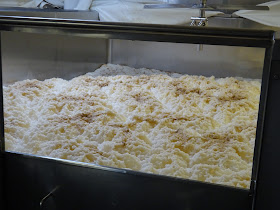My obsession with Landlord is entirely unrelated to this.
The brewhouse came from the wrong side of the Pennines, originally being from Oldham brewery. They recently added a new Steel's masher.
The mash tun was filled almost to the brim, giving a brewlength of 180 barrels which is liquored back to 250 bbl. They still work in Fahrenheit and unfortunately I brew in Celsius. Figures were kindly translated for us and they mash at 66°C for an hour, then underlet raising the temperature to 70°C and leave for another hour.
They use only whole hops and add more hops in the hop back.
A lot more hops go in the copper though.
And I bet it's a right pain in the arse filling those bins. The use WGV (Whitbread or is it White's Golding Variety), Fuggles and Savinjski Goldings, with true Goldings also being used some years.
Brewing sugars are used in wort production and priming sugar is added to the casks.
 |
| Blocks of No.2 there |
They carry out a range of lab tests in house...
...including using an antique Lovibond meter. Modern colour determination only measures colour at one wavelength (430nm) which does not give the full picture so they compare the colour of their beer to tinted glass slides by eye.
They ferment in open squares and rouse the yeast during fermentation. The yeast also came from Oldham brewery and they've been continuously re-pitching for 36 years.
They crop the yeast by skimming it off the top.
Newer vessels have lids that can drop down and seal the tanks. Which makes CIP (cleaning in place) easier and allows them to be used as conditioning tanks.
They now have a five barrel pilot plant which has been used for brewing some small batch beers.
Production is over 80% cask, with the rest being bottled at Robinsons. Annual production is 61,000 barrels so unsurprisingly they have very snazzy cask washing and racking equipment.
They still have to bang in the shives by hand mind.
With the casks being primed and racked with a yeast count of 2 million cells per ml there is a vigorous secondary fermentation. They recommend the cask is vented and left open for 24 hours before adding a soft peg.
The tour ended with a look at the Quality Control.
























I love Tayloyr's Landlord too. Its Yorkshire Bitter at its finest in a pub. However, having being involved in organising the odd beer festival in my time, I find it a nightmare for the uninitiated. Mainly due to the amount of secondary fermentation that has gone on by the time we receive it. It has been tapped and almost hit the ceiling!
ReplyDeleteCould you tell if they used any crystal/caramel malts? Or is the color strictly from invert? My memory has been of very little crystal or none at all. I have only had Landlord a couple of times when I was on holiday in England several years ago, but it was for sure the best pints of the trip. There are lots of home brew recipes with conflicting grain bills.
ReplyDeleteAll golden promise. I put the slight caramel taste down to diacetyl myself, but they didn't agree at the brewery
DeleteCan you reveal the hop schedule, roughly? I'm onto my 8th attempt at trying to emulate this in the US as I miss the cask so much.
ReplyDeleteI'll see if I can find my notes at the weekend. Have you tried the Graham Wheeler recipe? And have you got hold of the yeast?
DeleteThanks Ed, yes I've tried the Graham Wheeler recipe, it is close, but doesn't include the Invert sugar #2, and uses Goldings, Styrian Goldings, and more Styrian, rather than Fuggles, Whitbread Golding Variety and Savinjski. I use Wyeast 1469.
DeleteI ferment in an open bucket (with lid propped open with a thermo-well stuck in a carboy cap) in a chest freezer at 20C for ~7 days, rousing with a big spoon after 3 days. Then into a 20L Speidel with 100g priming sugar in solution, after another day at 20c, down to 12C in 2x 4C steps over 2 days. I've got a 5 imperial gallon batch that's been conditioning now for a week. Will leave it another two weeks. Made with 54g 4.4% Fuggles at 80mins to go, 14g 7.1% WGV and 6.6g 6.1% EKG at 20mins, 38g 3.7% Savinjski and 42g 2.6% Styrian at 0mins, left in while chilling. Pitched at 17C and let rise to 20C. (Started with 5kg golden promise, 450g British Crystal 135/165L, 250g torrified wheat, 67C for 60 mins, mash out at 76C for 10mins). I went over the top a bit with the amount 0mins hops. I'll be visiting the UK in the summer and staying at a couple of their pubs in Keighley. Haven't been able to arrange a tour though (that must have been amazing), but will tour Black Sheep.